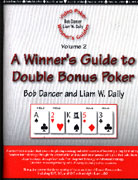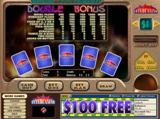More on Double Bonus Video Poker
Double Bonus Poker Variations & StrategiesThe Best Strategy for Double Double Bonus Video PokerPlaying Double Bonus PokerVideo Poker Machines - How to Choose
Winner's Guide Volume 2: 2nd Edition - Double Bonus Poker
by Bob Dancer
From the authors of the best-selling video poker strategy cards the Video Poker Winner's Guides cover both strategy and non-strategy aspects of play that are important for winning. Readers learn through the presentation and explanation of basic principles that take them through four levels of strategy. Strategies for full-pay as well as the more widely available non-full-pay versions are covered. Bob Dancer's well-publicized million-dollar win began with his mastery of these games.
The second edition of Volume 2 covers Double Bonus--including 10/7, 9/7, and 10/7 returning 80 for a straight flush--with standardized notation affording greater clarity and precision. A couple of strategy errors discovered in the first edition have also been corrected.
Double Bonus Video Poker Paying Back 99.1%!
Intercasino offers a Double Bonus video poker with a great payback percentage of 99.1%. Take what you've learned here at ReadyBetGo and have fun playing this great video poker variant!
Creating Flow Charts for Video Poker
by Bob Dancer
I don't play 9-5 Super Double Bonus very frequently. But when I do, I play it at the $2 Five Play level. This is high enough stakes ($50 per play) that I don't want to make mistakes. The game is Bob Dancer is one of the world's foremost video poker experts. He is a regular columnist for Casino Player, Strictly Slots, and the Las Vegas Review-Journa land has written an autobiography and a novel about gambling. He provides advice for tens of thousands of casino enthusiasts looking to play video poker. Bob's website is www.bobdancer.com complicated enough that I forget the fine points between playing sessions.
Bob Dancer is one of the world's foremost video poker experts. He is a regular columnist for Casino Player, Strictly Slots, and the Las Vegas Review-Journa land has written an autobiography and a novel about gambling. He provides advice for tens of thousands of casino enthusiasts looking to play video poker. Bob's website is www.bobdancer.com complicated enough that I forget the fine points between playing sessions.
 Bob Dancer is one of the world's foremost video poker experts. He is a regular columnist for Casino Player, Strictly Slots, and the Las Vegas Review-Journa land has written an autobiography and a novel about gambling. He provides advice for tens of thousands of casino enthusiasts looking to play video poker. Bob's website is www.bobdancer.com complicated enough that I forget the fine points between playing sessions.
Bob Dancer is one of the world's foremost video poker experts. He is a regular columnist for Casino Player, Strictly Slots, and the Las Vegas Review-Journa land has written an autobiography and a novel about gambling. He provides advice for tens of thousands of casino enthusiasts looking to play video poker. Bob's website is www.bobdancer.com complicated enough that I forget the fine points between playing sessions.For that reason, I've created a series of logic flow charts, which are the first documents I consult when I refresh my knowledge on the game. One of these is for an ace of one suit and "JT" of another. Usually you hold the "JT", but sometimes the A by itself is correct, and sometimes AJ. Although not explicitly stated in the chart itself, this chart excludes hands where higher-ranked combinations exist, such as A"JT"K6, A"JT7"4, or A"JT"55. I use the following chart, following the appropriate trail until I reach the correct play and see "--- end":
A versus "JT"
Is there a flush penalty to the "JT"?
If no, play "JT" -- end
If yes, continue
Is the fifth card suited with the A?
If yes, is it an 8 or 9?
If yes, play AJ -- end
If no, play "JT" -- end
If no, continue
If yes, is it an 8 or 9?
If yes, play AJ -- end
If no, play "JT" -- end
If no, continue
Is the fp to the "JT" a 6, and the fifth card a 7?
If yes, play A -- end
If no, continue
If yes, play A -- end
If no, continue
Is the fifth card an 8 or 9?
If yes, play A -- end
If no, play "JT" -- end
This is my chart. Here's another. This deals with AJ unsuited.
If yes, play A -- end
If no, play "JT" -- end
This is my chart. Here's another. This deals with AJ unsuited.
AJ unsuited -- I know that AKT and AQT (including the cases where the ten is suited with one or the other high cards) follow the same rules, except that holding a solitary K or Q never happens in these hands.
Is there a T?There are numerous ways to present the same information, but this works for me. My chart is indented, which may or may not translate easily to the webpage, so each "If yes," is indented to the same degree as the corresponding "If no." I suspect people with computer programmer training will find this chart easier to comprehend.
If yes, is the T suited with the J?
If yes, go to 'A versus "JT" chart -- end
If no, is the T suited with the A?
If yes, are any cards suited with the J?
If yes, hold AJ -- end
If no, are any cards 7, 8, or 9?
If yes, hold AJ -- end
If no, hold J -- end
If no, are any cards suited with the J?
If yes, are any cards suited with the A?
If yes, hold AJ -- end
If no, is there more than one lsp?
If yes, hold A -- end
If no, hold J -- end
If no, are two cards lsp?
If yes, hold J -- end
If no, hold A -- end
If no, is there a 9 or 8?
If yes, hold AJ -- end
If no, is any card suited with J?
If yes, hold AJ -- end
If no, hold J -- end
When I decide to get ready to play 9-5 SDB again, I spend about 5 minutes with each chart, testing various hands on WinPoker. I doesn't take long because when the charts are in this format, it's easier for me to see the whole picture and to concentrate on the key distinctions.
Once I've reviewed each of the flow charts, I pull out the strategy sheet and review it. It's really pretty simple, outside of the information in the flow charts. There are a few types of hands with simple exceptions (such as when to hold Q from a "QT" combination or when is "JT9" superior to a low pair) that are sufficiently uncomplicated that I don't need a flowchart. With the strategy sheet and flow charts in front of me, I set WinPoker to deal hands where the top two hands are less than 0.02 coins apart, and I practice for 15 minutes or so. After I've done this, now I'm ready to go to the casino.
You're welcome to use the preceding charts, of course, but the real benefit comes in creating the chart, not in using the chart. Creating the chart requires mastery of the subject matter. It's not that difficult if you've studied the Winner's Guides and understand the logic behind penalty cards. And it will put you head and shoulders above other players, who frequently seek the easy way out.
Part of my reason for publishing flow charts for a relatively-obscure game is to show the way rather than to pave the way. (You'll do better paving your own way.) Players who play Double Bonus will find this a good format for analyzing unsuited AK, AQ, and AJ hands. Joker Wild players (including KBJW, 2PJW, and even Double Joker) will find this a good way to select mid-cards --- with or without the joker(s).
I'm sometimes asked if video poker is actually this complicated, and whether it's really necessary to go through all of this. My answer is that it is necessary for me to go through this in order to obtain the results I want. For those smarter than me, more naturally skillful in the game, or those having lesser expectations of success, perhaps it isn't necessary.
[ learn video poker! ]

